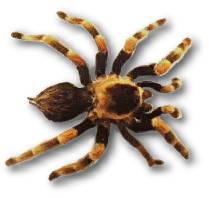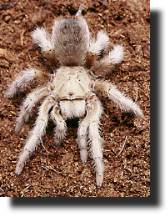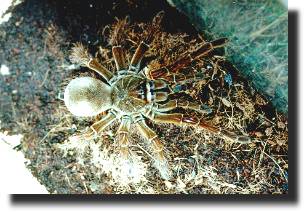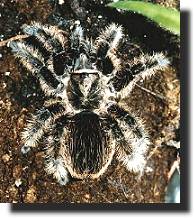Tarantulas are found worldwide; there are over eight hundred different species of them! These big, hairy spiders eat insects, small birds and reptiles, and also other spiders. These spiders are found in tropical and sub-tropical areas, like South America, Central
America and the south-western states of the USA, Africa, parts of the Middle East, southern Asia (including India and Sri Lanka),
much of Polynesia, Australia, northern parts of New Zealand and much of the Caribbean.
 Tarantulas are solitary, and do not easily tolerate others of the same species. Because of their large size, they don't construct intricate "catching webs" like most spiders do. They can spin webs, however, which they use to line their burrows. The male of the species is only sexually mature for the last few months of his
life. Males generally live 9-10 years, but females live as long as twenty years. The female lays eggs in a sack woven from web silk, which is carried attached to the abdomen until the eggs hatch. The sack may contain 300-1000 eggs, which hatch in sixty to ninety days. A hatchling tarantula is about the size of a pencil point. Tarantulas are solitary, and do not easily tolerate others of the same species. Because of their large size, they don't construct intricate "catching webs" like most spiders do. They can spin webs, however, which they use to line their burrows. The male of the species is only sexually mature for the last few months of his
life. Males generally live 9-10 years, but females live as long as twenty years. The female lays eggs in a sack woven from web silk, which is carried attached to the abdomen until the eggs hatch. The sack may contain 300-1000 eggs, which hatch in sixty to ninety days. A hatchling tarantula is about the size of a pencil point.

Tarantulas overpower their prey with sheer force, and inject it with venom. The venom is a combination of a paralyzing agent and digestive secretions. They will generally only eat live food, although some
will accept dead prey and some big spiders will apparently eat small pieces of raw meat. After catching and
killing their prey, tarantulas inject it with powerful digestive enzymes that liquefy the insect's contents.
When the insides have been sufficiently liquefied, the tarantula sucks the insect dry and throws away the
empty husk.
Tarantulas, like all spiders, have eight legs. Some species might look like they have ten - the additional
two legs being a pair of shorter limbs located right at the front. These extra "legs" are actually pedipalps,
which are sort of like arms. A tarantula uses its pedipalps for manipulating prey, amongst other things.
 All spiders have venom glands. Most tarantula bites, however, are not generally harmful to man unless someone happens to be allergic to the venom. But their formidable fangs can produce painful puncture wounds. Tarantulas are invertebrates. This means that they have an external skeleton (exoskeleton) - as distinct from the internal skeleton like humans have. All spiders have venom glands. Most tarantula bites, however, are not generally harmful to man unless someone happens to be allergic to the venom. But their formidable fangs can produce painful puncture wounds. Tarantulas are invertebrates. This means that they have an external skeleton (exoskeleton) - as distinct from the internal skeleton like humans have.
Since exoskeltons are generally hard and inflexible, they do not allow the spider to grow, so the spider must discard its "shell" in order to get bigger. This process is commonly known as moulting.
 Are tarantulas dangerous? Some tarantulas are more dangerous than others. Western hemisphere spiders tend to rely more on urticating hairs (hairs that cause irritation) than biting, as a method of defense, and even if
they do bite, their venom isn't particularly strong. However, the venom of some African and Asian species are thought to be
much more toxic. Are tarantulas dangerous? Some tarantulas are more dangerous than others. Western hemisphere spiders tend to rely more on urticating hairs (hairs that cause irritation) than biting, as a method of defense, and even if
they do bite, their venom isn't particularly strong. However, the venom of some African and Asian species are thought to be
much more toxic.
Reassuringly, there are no reliable reports of any death resulting from someone being bitten by a pet tarantula. However, a large tarantula (e.g., one with a 6" leg span) could give you a very painful
wound, similar to a bee or wasp sting, ... but they don't generally attack unless provoked (although many
tarantulas are notoriously unpredictable, so you shouldn't assume anything). In general, however, you're far
more likely to be scratched by your cat or bitten by your dog, and far more people die from being bitten by
snakes than spiders.
 The Mexican Blonde Tarantula The Mexican Blonde Tarantula
Natural Habitat: Southern Arizona and Northern Mexico
Body Length: 2.4-2.8 inches (6-7 cm)
Disposition: Very docile, easy to handle.
Body Color: Males are slate blue with a pale carapace and
reddish abdomen. Females are a pale tawny color, with darker
leg segments.
|
 Goliath Bird-Eating Tarantula Goliath Bird-Eating Tarantula
Natural Habitat:
South America
Body Length: 4-5
inches (12 cm)
Leg Span: Up to 10
inches (25 cm)
Body Color: dark
coffee brown
Extremely
aggressive; should not be handled. Irritating urticating hairs. Find out more here.
|
 Curly Haired Tarantula Curly Haired Tarantula
Natural Habitat: Costa Rica
Body Length: 6 to 7 cm
Body Color: Brown, with gold on
cephalothorax.
Distinctive Characteristics:Frizzy hairs on
the legs and abdomen.
Very peaceful, makes a great pet.
Easy to handle.
|
Resources
|